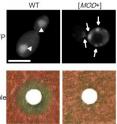New yeast prion helps cells survive
One of the greatest mysterious in cellular biology has been given a new twist thanks to findings reported in Science. Researchers at the RIKEN Brain Science Institute show that prions, proteins that transmit heritable information without DNA or RNA, can contribute to drug resistance and cellular adaptation. Their discovery of a yeast prion with these properties demonstrates the active role of the prion conversion in cellular fitness adaptation, providing new insights into the potentially broader function of prions in living organisms. Since their discovery in the 1960s, the class of misfolded proteins known as prions has posed a fundamental challenge to the foundation of molecular biology: the idea that heritable information flows from DNA and RNA to protein, but never from protein to any other molecule. Contrary to this rule, prions are able to transmit information from one molecule to another through the transmission of their misfolded shape, with devastating consequences in diseases such as mad cow disease and Creutzfeldt-Jakob disease. The broader implications of this unusual transmission mechanism, however, are not well understood.
Among these implications, research on yeast prions has suggested that beyond their well-known role in diseases, some prions may confer survival advantages by helping organisms respond to environmental stress. To explore this idea, the BSI research team screened a wide range of different genes in budding yeast for previously-undiscovered prions. Out of 6000 genes screened, they found a new yeast prion protein "Mod5" with the unusual property that it lacks the glutamine and asparagine-rich amino acid sequences characteristic of other yeast prions. Sequences like these are thought to contribute to forming amyloid aggregates, the mechanism by which prions propagate.
Despite lacking these sequences, Mod5 forms amyloid aggregates just like other yeast prions. Unlike the destructive role such aggregates play in well-known prion diseases, however, the researchers showed that Mod5 aggregates actually help the yeast, by granting it cellular resistance to antifungal agents. This advantage is so important that the yeast actually increases prion conversion when the pressure is on, as the researchers found when they applied antifungal drugs to the yeast.
These results demonstrate that the Mod5 yeast prion contributes to cell survival under environmental stress, through selection playing a key role in evolutionary adaptation. This insight marks a breakthrough in our understanding of the evolutionary role of prions and their unique form of inheritance, promising new avenues in the battle to contain and treat some of the world's most dangerous infectious diseases.
